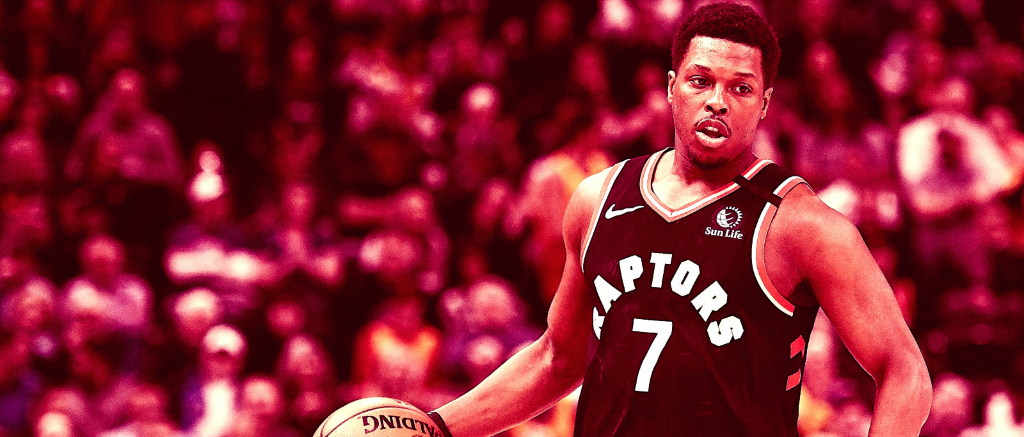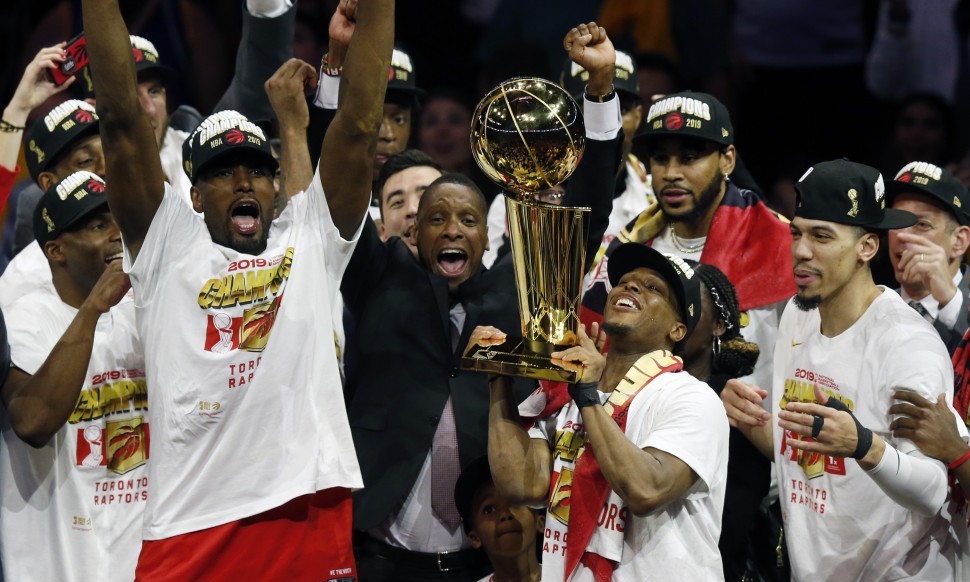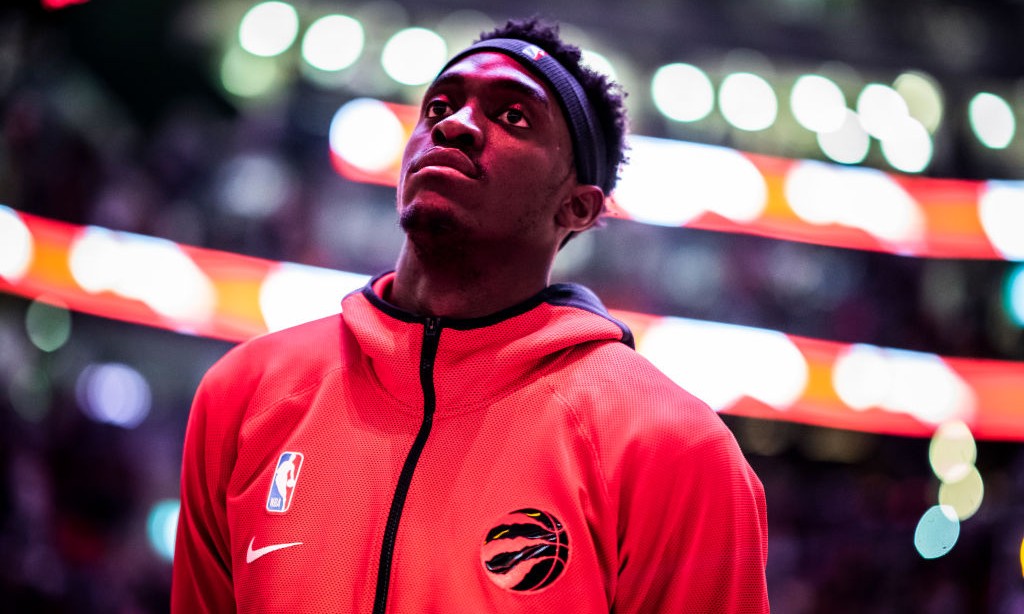
The 2019-2020 NBA season came to an abrupt halt on March 11 due to the COVID-19 pandemic. With the season effectively three-quarters of the way through, many storylines, records-to-be, and developing comebacks were left in the lurch; all the bizarre, beautiful, and too-absorbing minutiae of the league halted. This is a look back at the most compelling of those suspended narratives in an attempt to figure out what could have been while reconciling, maybe wrenchingly, that however the season concludes, this will be a year in basketball that never fully happened. Welcome to Year None.
The qualifications for a basketball team to receive the coveted “dynasty” label seem to start, at a minimum, of two titles and a handful of sequential runs at it, a lot of time comfortably spent in the postseason. No team with the distinction arrived to it the same way, but when they did the end result was the same, an overt dominance of the league.
At the core of these competitive, occasionally cold-blooded teams are a set of stars revolving around one larger body: a superstar. The inner workings of the team are slanted toward that monolithic figure — keeping them competitive, keeping them happy, keeping them. It has historically made for teams with loose ties to one another, where supporting players rotate in and out a little quicker at the behest of what’s best for the core, creating pockets of personal relationships within a team’s roster. Lost in this are through-lines of verbal and psychic communication, an overarching feeling of what the team is to one another, and ultimately a generosity that extends out from the anchor points, be them stars or veterans, that gives the team a recognizable shape from season to season. All those things are factors in team chemistry, and it’s what makes a group magic.
This is not to say teams that win titles are all lacking in chemistry, only that many will find themselves forfeit after years of streamlining, shearing themselves of personality, anything less optimized than performance-based, in order to propel ascendancy and ultimately achieve dynasty. But what about teams that opt for that added emotional weight, reluctant to be ruthless with their rosters and even favoring continuity as an advantage? There aren’t stats to hold against teams flush with chemistry when it comes to their wins and whether perpetuating rapport over ruthlessness results in banners to hoist to the rafters.
Well, there weren’t, but then the Toronto Raptors became NBA champions.

Toronto is a chemistry dynasty. The emotional effervescence of its present suspended season started as soon as former general manager Bryan Colangelo, the one who let Chris Bosh walk and sought star marketability in Rudy Gay, was ousted for Masai Ujiri. His big initial shakeups — ditching Andrea Bargnani, seeing the mismatch in Gay — turned into opportunity for the franchise’s last holdout of hope, DeMar DeRozan, and a reluctant Kyle Lowry. At the end of their first and lackluster season together, DeRozan approached Lowry, and asked him to commit to the team, something a few coaches had tried and what Lowry had, until then, not been inclined to do. It clicked for them, and while Toronto lost to the Nets in the first round of the playoffs the following year, it was the first time DeRozan set foot in the postseason and the first wrenching moment of many, many more Lowry would have there.
So they built. The roster was slow to shift, DeRozan and Lowry two complimentary counterweights at the center, but the chemistry ramped. As in traditional dynasties, Toronto optimized, but had to get creative in honing what it already had. Investing time and energy into its G League affiliate created a wider bridge for two-way development in rookies and undrafted prospects, players who from day one would uphold the cultural tenants of the team even as they — Fred VanVleet, Norman Powell, Pascal Siakam — grew into its future leaders. Quick, bright flashes in loaners like Lou Williams and P.J. Tucker showed gaps the front office could work to fix while vaulting Toronto ahead each time a specialized player left for how they grew into that space. Gaining skill and personality, players thoughtfully brought in under Ujiri — and later, Bobby Webster — would also work as a window, a glimpse into where the team could go.
As with skill, chemistry can plateau, too much of the same repetition yielding no new result. Replacing Dwane Casey with Nick Nurse allowed an instant acceleration, fresh eyes that held the muscle memory of the franchise and a voice that was already trusted. Nurse was handed what on other teams could have been an atomic bomb of a trade, vaporizing five years of carefully crafted chemistry. DeRozan’s departure was the biggest rattle the Raptors of this era ever had, including all the years of “Lebronto,” but they got Kawhi Leonard, a title, and a new kind of leader in Lowry from it. The former left, ultimately another (albeit the greatest of them) loaner, but the latter two have been formulaic in the identity of the team this season and what it will be going forward.
The ring does things. It’s why dynasties last. Its gold light catches on everything, validating teams, inflating future salaries of its players whether they stay or go, attracting new talent. Like the glint of it, it adds an edge to what plays out on the court. Toronto this season could’ve been a lieu year, an in-between while management put new pieces around Siakam and its young core, reducing Lowry, Serge Ibaka, and Marc Gasol. It’s what many seemed to expect. Not that the title was fluke, only that it was a perfect storm. With Leonard and the unheralded Danny Green gone, how would the Raptors, who had not seemingly gained anyone in the offseason, compete? The ring does things but so does chemistry, and the two together, along with Lowry’s one-year, good-faith contract extension and Siakam’s new four-year deal, were the tells the team let slip that this season was going to be all-in.

Toronto was on track to register a franchise-high in wins, until Lowry’s thumb, the one he guarded in an oven mitt all through the Finals, buckled and he needed surgery. Ibaka went down in the same November game as Lowry with a sprained ankle. OG Anunoby was next when a returning Leonard popped an elbow into his eye socket. Then Matt Thomas (broken finger), VanVleet (knee contusion), Powell (shoulder), Gasol (hamstring), Siakam (groin); it wasn’t even Christmas and the injuries all tallied together looked insurmountable.
But the team kept winning. Nurse put out a new Frankenstein’s monster of a lineup night after night, leaning on the foundational tenants of Raptors basketball: scrappy and weird gameplay, smothering defense, intrinsic trust that a dark horse would emerge in the clutch.
Take, for instance, Terence Davis. The undrafted wing who emerged from out of nowhere if you’d never paid attention to where Toronto has pulled some of its most dogged players from. Davis showed up fearless against guys twice his size and triple his salary, crashing boards, yanking the ball from their hands, mouths agape after him. His minutes ticked up along with his resolve. Off the court, Davis is sincere to the point of appearing bashful. His voice cracks often, like his heart is in his throat. He’s called Ibaka “a light in my life” and praised the leadership of Lowry and VanVleet, their encouragement to come to them always, with anything.
Once Nurse called him out publicly for not understanding how hard the team plays, Rondae Hollis-Jefferson began to fit like a glove. He made up for his lack of team fluency by heaving his body where it was best put to use: sliding screens, reaching rebounds that pop joints. Thomas, when he got healthy, showed up as a pocket shooter. Chris Boucher vaulted to the rim like a shadow shot out from his own intent, long and menacing, haunting the dreams of everyone he dunked on.
The rhythm kept up even as guys continued to fall. It seemed like the cruelest relay — when someone returned, another went out. Toronto never played with a full, healthy roster all season, not even in the middle of its 15-game win streak. Its defensive rating climbed from fifth last season to second in 2019-20. The Raptors ranked higher in steals, assists, and effective field goal percentage from their championship season, with multiple players sitting in the top-20 league-wide in each category. Improvisation remained the go-to play, and few teams had an answer for it, or for how relentless, how hungry, how cheerful the Raptors stayed throughout. The mood, from October on, was assured. There was a new kind of airiness in the way the team carried itself. Gone were the desperation minutes that could settle like a shroud, tough to shake.
Toronto was always good at edging out wins, but they were ugly, tired wins. The levity the team was showing now that they’d pocketed the chip on their shoulder and wore it around their fingers, was the result of a sustained walk through the fire. The playoffs, the Finals, it was a long road the team had never traveled before. Watching them in October, or when they came back from 30 points down against Dallas in December, or as injuries mounted in January, or as February’s cold clamped down to snap their win streak, this was a team that had hit its stride. The Raptors were no longer running to catch up, they were running for the satisfaction of seeing all the strange ways they could move, twist, romp around to easily win.
The loss of this season for Toronto is a grift for the league, for its weirdest and best bouts of history. To not know what would have happened if the whole roster, so many contracts just about up, got healthy. A team that was expected to slink away instead becoming the season’s most joyful menace, best exemplified by Lowry, planting his feet at All-Star and taking two successive charges (it would have been three, but the first one went uncalled, ostensibly because there is no way on Earth the official could fathom that someone would try to draw a charge in the All-Star Game). How instantly, deeply, under the skin of LeBron James and James Harden he dug, how Leonard, as best he could, laughed. Lowry, body planked across the high sheen of the Chicago court, grinning, arms raised, knowing he will be lifted.
He is, of course, the secret ingredient to Toronto’s chemistry. Lowry is still the most combustible element, but made dulcet as a leader, referring colloquially to teammates as “beloved” and roiling with the kind of satisfaction that getting what you’ve worked every inch of your body for, for years, will bring.
